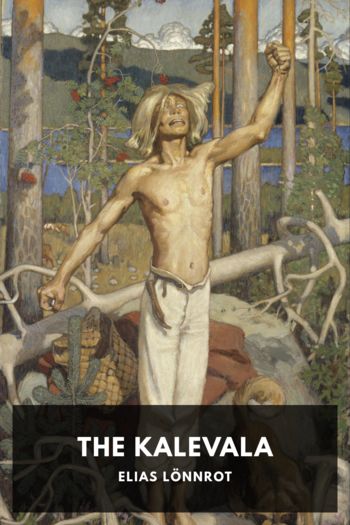The Kalevala, Elias Lönnrot [easy novels to read TXT] 📗

- Author: Elias Lönnrot
Book online «The Kalevala, Elias Lönnrot [easy novels to read TXT] 📗». Author Elias Lönnrot
Certain beasts, and birds, and trees, are held sacred in Finland. In the Kalevala are evident traces of arctolatry, bear-worship, once very common among the tribes of the north. Otso, the bear, according to Finnish mythology, was born on the shoulders of Otava, in the regions of the sun and moon, and “nursed by a goddess of the woodlands in a cradle swung by bands of gold between the bending branches of budding fir-trees.” His nurse would not give him teeth and claws until he had promised never to engage in bloody strife, or deeds of violence. Otso, however, does not always keep his pledge, and accordingly the hunters of Finland find it comparatively easy to reconcile their consciences to his destruction. Otso is called in the runes by many endearing titles as “The Honey-Eater,” “Golden Light-Foot,” “The Forest-Apple,” “Honey-Paw of the Mountains,” “The Pride of the Thicket,” “The Fur-robed Forest-Friend.” Ahava, the West-wind, and Penitar, a blind old witch of Sariola, are the parents of the swift dogs of Finland, just as the horses of Achilles, Xanthos and Belios, sprang from Zephyros and the harpy Podarge.
As to birds, the duck, according to the Kalevala, the eagle, according to other traditions, lays the mundane egg, thus taking part in the creation of the world. Puhuri, the north-wind, the father of Pakkanen (frost) is sometimes personified as a gigantic eagle. The didapper is reverenced because it foretells the approach of rain. Linnunrata (bird-path) is the name given to the Milky-way, due probably to a myth like those of the Swedes and Slavs, in which liberated songs take the form of snow-white dovelets. The cuckoo to this day is sacred, and is believed to have fertilized the earth with his songs. As to insects, honeybees, called by the Finns, Mehilainen, are especially sacred, as in the mythologies of many other nations. Ukkon-koiva (Ukko’s dog) is the Finnish name for the butterfly, and is looked upon as a messenger of the Supreme Deity. It may be interesting to observe here that the Bretons in reverence called butterflies, “feathers from the wings of God.”
As to inanimate nature, certain lakes, rivers, springs, and fountains, are held in high reverence. In the Kalevala the oak is called Pun Jumalan (God’s tree). The mountain-ash even to this day, and the birch-tree, are held sacred, and peasants plant them by their cottages with reverence.
Respecting the giants of Finnish mythology, Castrén is silent, and the following notes are gleaned from the Kalevala, and from Grimm’s Teutonic Mythology. “The giants,” says Grimm, “are distinguished by their cunning and ferocity from the stupid, good-natured monsters of Germany and Scandinavia.” Soini, for example, a synonym of Kullervo, the hero of the saddest episode of the Kalevala when only three days old, tore his swaddling clothes to tatters. When sold to a forgeman of Karelia, he was ordered to nurse an infant, but he dug out the eyes of the child, killed it, and burned its cradle. Ordered to fence the fields, he built a fence from earth to heaven, using entire pine-trees for fencing materials, and interweaving their branches with venomous serpents. Ordered to tend the herds in the woodlands, he changed the cattle to wolves and bears, and drove them home to destroy his mistress because she had baked a stone in the centre of his oat-loaf, causing him to break his knife, the only keepsake of his people.
Regarding the heroes of the Kalevala, much discussion has arisen as to their place in Finnish mythology. The Finns proper regard the chief heroes of the Suomi epic, Wainamoinen, Ilmarinen, and Lemminkainen, as descendants of the Celestial Virgin, Ilmatar, impregnated by the winds when Ilma (air), Light, and Water were the only material existences. In harmony with this conception we find in the Kalevala, a description of the birth of Wainamoinen, or Vaino, as he is sometimes called in the original, a word probably akin to the Magyar Ven, old. The Estonians regard these heroes as sons of the Great Spirit, begotten before the earth was created, and dwelling with their Supreme Ruler in Jumala.
The poetry of a people with such an elaborate mythology and with such a keen and appreciative sense of nature and of her various phenomena, was certain, sooner or later, to attract the attention of scholars. And, in fact, as early as the seventeenth century, we meet men of literary tastes who tried to collect and interpret the various national songs of the Finns. Among





Comments (0)